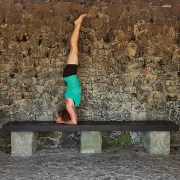 Photo: Getty Images
Photo: Getty Images
The first time I attempted a headstand (sirsasana) during yoga practice, I was alone in a hotel room reading instructions from a book. Not moving as slowly and mindfully as headstand requires, I barreled over and tweaked a muscle in my neck. Years passed before I mustered up the courage to even try the pose again. Yes, dear teachers, I really was cowering in the back of the studio to avoid sirsasana! And even now, I approach the posture with caution and a bit of trepidation.
Sirsasana, literally “head posture” in Sanskrit, is often referred to as the King of postures, accompanied by its Queen, sarvangasana (shoulderstand). Leslie Peters explores this nomenclature and its symbolism in a Yoga Journal article. Headstand rightfully earned its regal position because of its many physical and mental benefits; but do its benefits outweigh its risks?
Intermediate and advanced yogis love practicing headstand for many reasons. Headstand strengthens the arms, legs, neck, and upper back while toning the abdominals and supporting the lungs. It has been said to help relieve symptoms of asthma, sinusitis and menopause and also is used therapeutically for insomnia and infertility. Moreover, any inversion increases blood flow to the brain, increasing mental alertness.
Nevertheless, all of these benefits come with a string of cautions. People with back or neck injuries, high or low blood pressure and heart conditions are advised not to practice headstand at all. Several medical studies have shown that intraocular pressure is increased when a person moves from an upright to an inverted position like headstand. This is particularly problematic in persons with glaucoma. One study even reported sudden loss of vision in an older man practicing headstand without supervision.
Beginners might prefer to practice the pose under the guidance of a yoga teacher. Even for the strongest of yoga practitioners, this king of postures can do a lot of damage if not performed correctly.
Perhaps the most common error when practicing headstand is placing too much weight on the head and neck. Deann Ohler, D.C., a Palo Alto, California-based chiropractor and yoga practitioner, has mixed feelings about headstands. “I think inversions are wonderful and one of the best parts of yoga, as far as I’m concerned. But in tripod headstand there is too much compression on the cervical spine. A supported headstand, putting more force on the forearms and less on the spine, is a much better option.”
One way to alleviate the pressure on the cervical spine is to practice against a wall and to lift the head slightly off the ground before kicking up into the headstand, pressing into the forearms and placing most of the weight on the shoulders and arms.
Proper alignment once in the posture can help prevent injury. Julie Gudmestad, P.T., offered alignment tips in her article “Save Your Neck.” Though an inverted position can be disorienting, Gudmestad stressed the importance of pulling the shoulder blades toward the hips, working against gravity. “The small cervical vertebrae are designed to support only the weight of the head, but when we do headstand, they are supporting nearly the full weight of your body,” she wrote. “Unless you have developed enough strength in the arm and shoulder muscles to take a little of the weight off your head and to balance the body if it shifts around slightly in headstand, you can injure your neck.”
As in any yoga practice, postures should be performed with ahimsa, or the avoidance of harm. When practiced carefully and mindfully, headstand can provide many benefits to the yoga practitioner.
Yoga Journal
”Save Your Neck”
American Academy of Opthalmology
”Central Retinal Vein Occlusion Following Sirsasana (Headstand Posture)”
Hillary Easom is a yoga teacher in the San Francisco Bay Area. She practices headstand...sometimes.






Add a Comment2 Comments
The National Posture Institute is a great resource for additional posture and body alignment information and education (you can become a certified posture specialist). If you get a chance check it out, you may find it interesting: www.npionline.org
May 6, 2011 - 1:23pmThis Comment
I am unfamiliar with this Institute but will definitely take a look at their website.Thanks!
May 9, 2011 - 11:19pmThis Comment